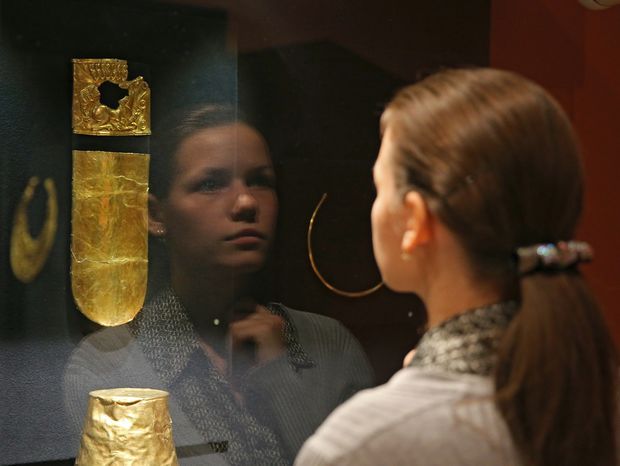Scythian gold has returned to Kyiv
Crimean exhibits will remain in Amsterdam pending the court decision
Kyivites and guests of the capital saw the Scythian gold again on September 9 for the first time since its return to Ukraine. All 19 exhibits owned by the Museum of Historical Treasures of Ukraine in Kyiv, including a Scythian helmet, a golden Scythian sword and sheath, Sarmatian jewelry and other items have already arrived to the Kyiv Monastery of the Caves. Some of them have returned to their place in the permanent exhibition of the museum, and some have gone back to the storage rooms. Exhibits from Simferopol, Kerch, Bakhchisarai, and Chersonese will remain in the last exhibition’s location until the legal issues are resolved in court.
COMMENTARY
Liudmyla STROKOVA, Director of the Museum of Historical Treasures of Ukraine:
“We launched the project ‘Crimea, a Golden Island in the Black Sea’ in 2012, which involved four Crimean museums and the Museum of Historical Treasures of Ukraine in Kyiv. The bulk of the exhibits, as many as 565 of them, were provided by the Crimean museums, while our museum sent 19 exhibits to it. The exhibition started on July 3, 2013 in Bonn (Germany) and moved to Amsterdam (The Netherlands) at the end of January 2014. According to the agreement, this exhibition was to end on May 28, but the Allard Pierson Museum (Archaeological Museum of the University of Amsterdam) decided that the exhibition was very interesting, and so it ought to continue for the summer. Therefore, all directors of the participating museums signed an additional agreement on the opening day, February 6, 2014, and the exhibition was extended until August 31. We flew to Amsterdam on the last day of the show and returned our exhibits to Ukraine on September 4.
“Insurance value of the 19 Kyiv exhibits approaches 11.5 million euros, while insurance value of the 565 Crimean exhibits is 1.5 million. This difference can be explained by the fact that the Kyiv museum’s exhibits are made of gold, silver, and bronze, while the Crimean museums’ exhibits include also stone, ceramic, glass, and bone pieces. The Kyiv exhibits date from the 4th century BC (Scythian items) and the 1st century AD (Sarmatian items). These are, in particular, the golden Scythian helmet, the golden Scythian sword and sheath, and the Sarmatian jewelry, including both ornaments and household items.
“The Allard Pierson Museum made an official statement on August 20 which is posted on their website, maintaining that it could not take responsibility for transferring the Crimean exhibits to Ukraine or Crimea, and thus left the determination of their fate to court. Accordingly, security was very high at the time of preparing the Kyiv exhibits for transportation: there were a lot of guards who did not allow any outsider into the museum, even the press. Two of our employees went to pick up our museum’s exhibits there, because the agreement allowed only our museum workers to uninstall the Kyiv exhibits from the showcases. We then checked the status of the exhibits, received them, signed certificates for the Ukrainian side and the Dutch side, and laid boxes with exhibits into a special container. On September 3, we went by car to Frankfurt and transferred to a Kyiv-bound plane there. Our exhibits have been put into place in three exhibition halls, they are available for Kyivites and guests of the capital to see. Over the six months it spent in Amsterdam, this exhibition was visited by about 35,000 people. We had a full house on the closing day. About as many people saw our exhibits in Bonn.
“In my opinion as both a museum worker and a citizen, Crimea is now a temporarily occupied part of Ukraine. Cultural heritage of Crimean museums, now staying in Amsterdam, is part of Ukraine’s museum collection. Therefore, this exhibition should be returned only to Ukraine. Given that we have a law on occupied territories, and the international law has provisions concerning this issue as well, cultural heritage cannot be imported into the occupied territories. It should be stored temporarily on the Ukrainian-controlled soil. The Crimean exhibits remain at the exhibition showcases, sealed up in February during the installation of the exhibition. The exhibition has not been dismantled, but it has been closed to the audience. Insurance on all exhibits ends on September 20, and the Amsterdam museum will buy new insurance on the Crimean exhibits at their own expense covering them from September 21 on, and the party which will win the litigation will have to reimburse the museum for the insurance. An inter-agency working group has started its work, which includes representatives of five ministries and should resolve legal issues with representatives of the Amsterdam institution. The official position of The Netherlands is that Crimea is a temporarily occupied part of Ukraine.”






